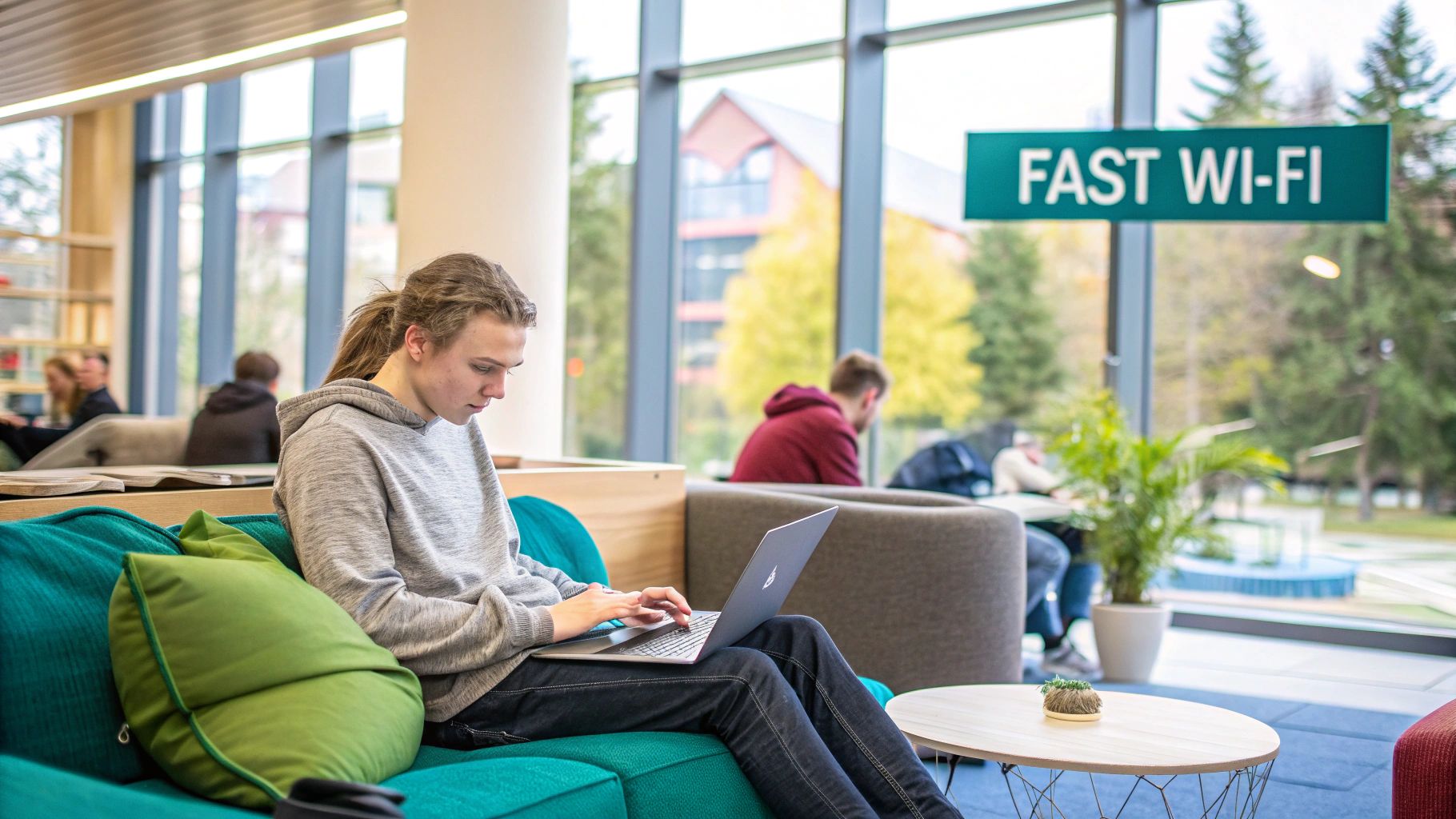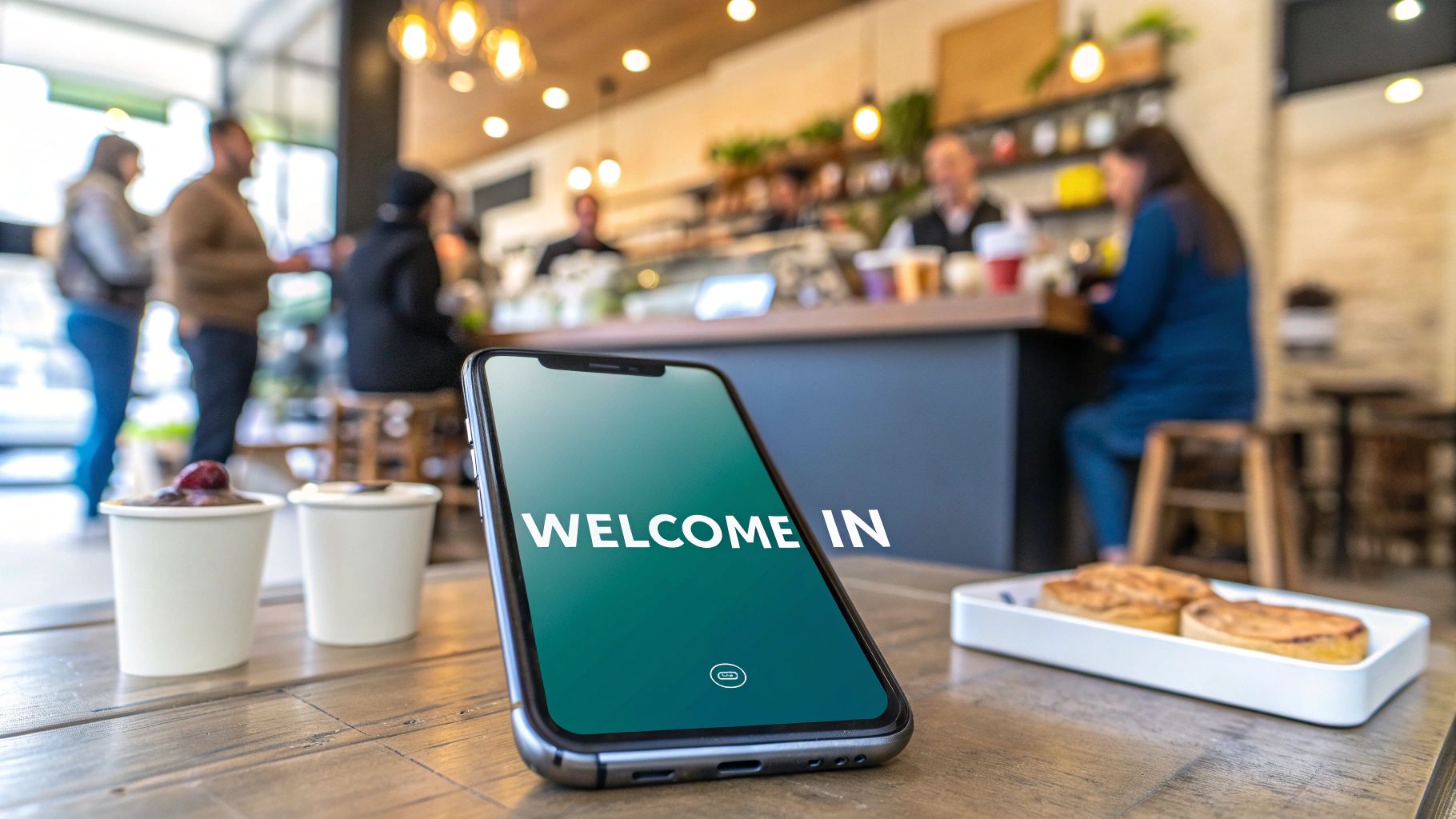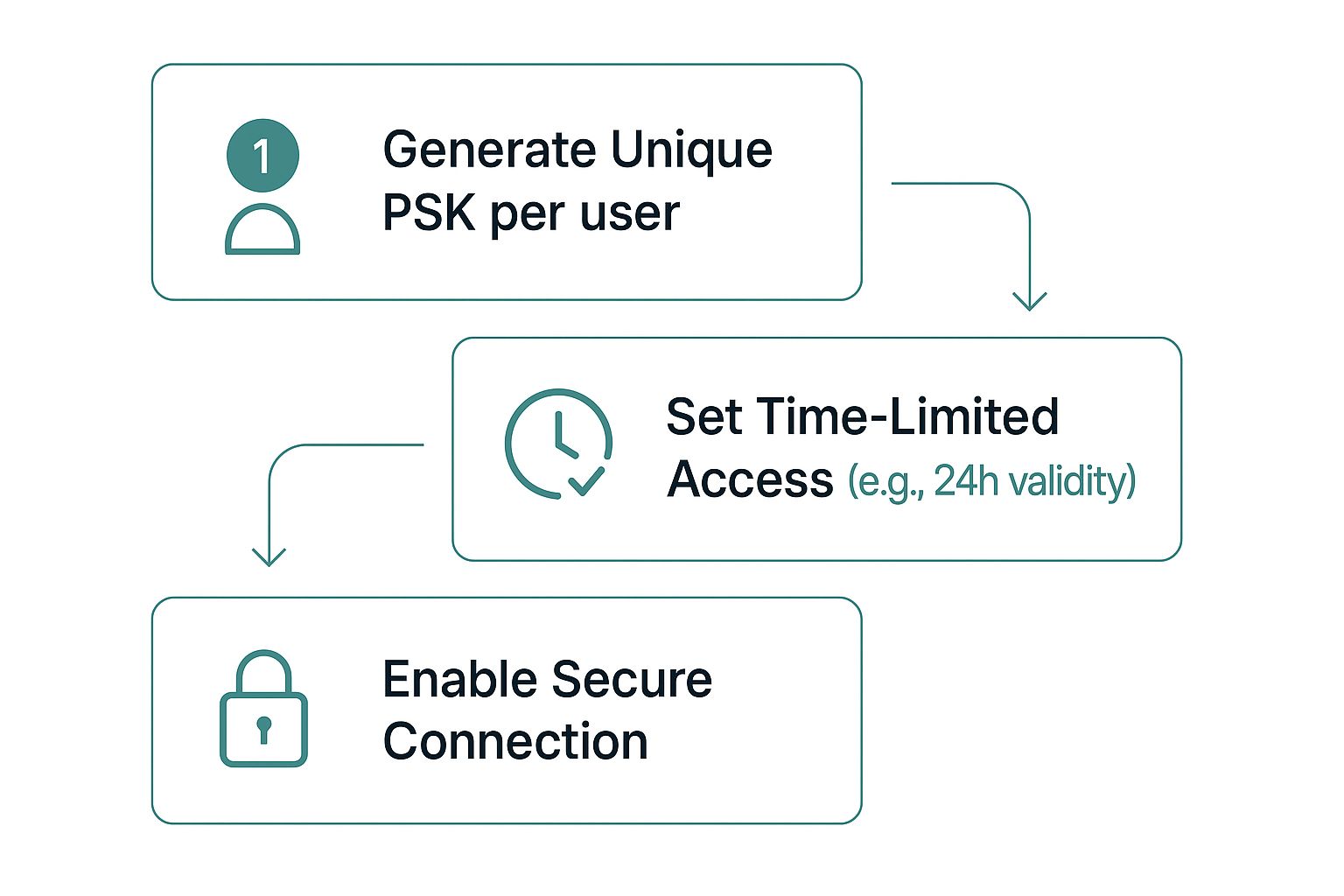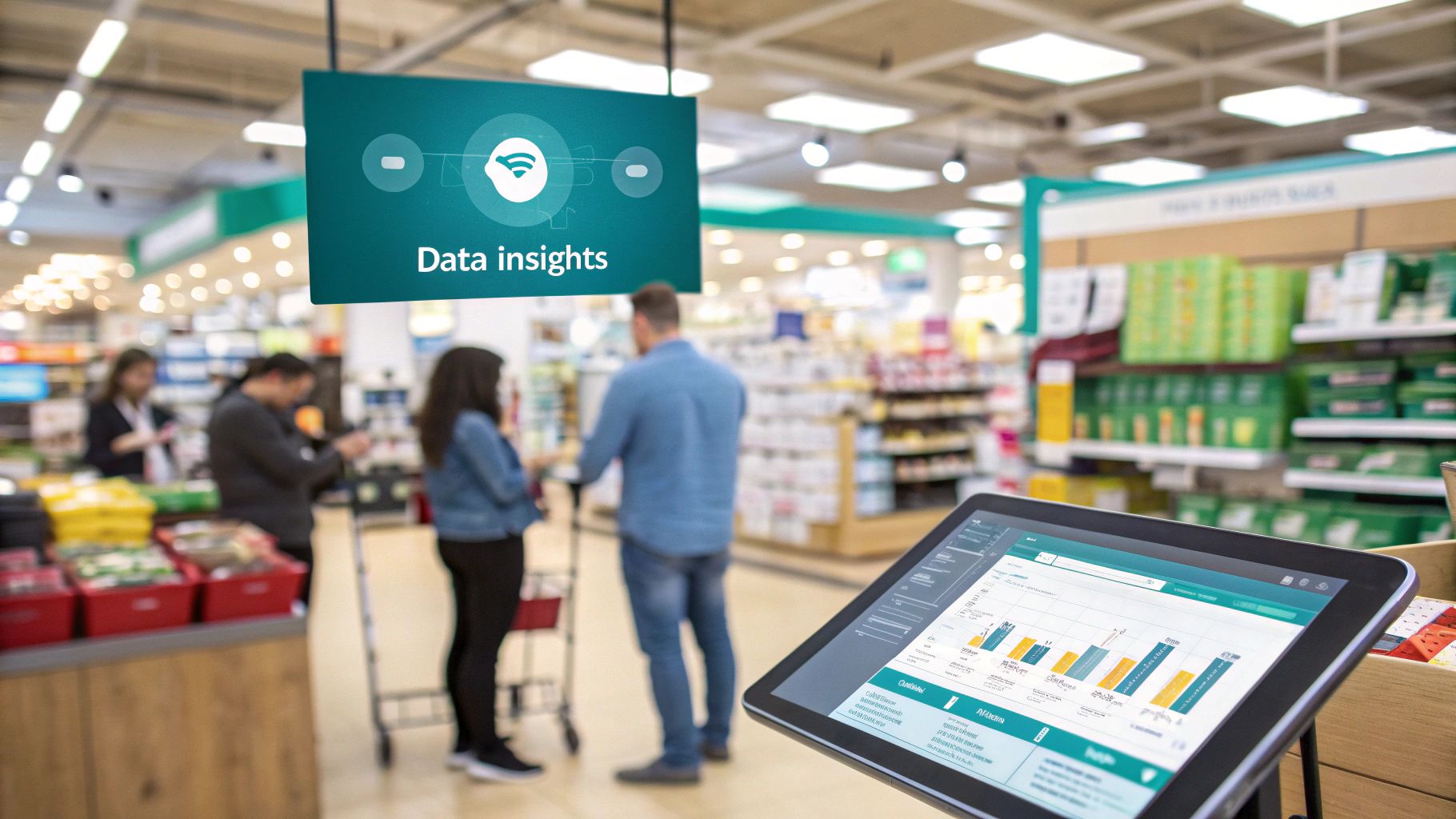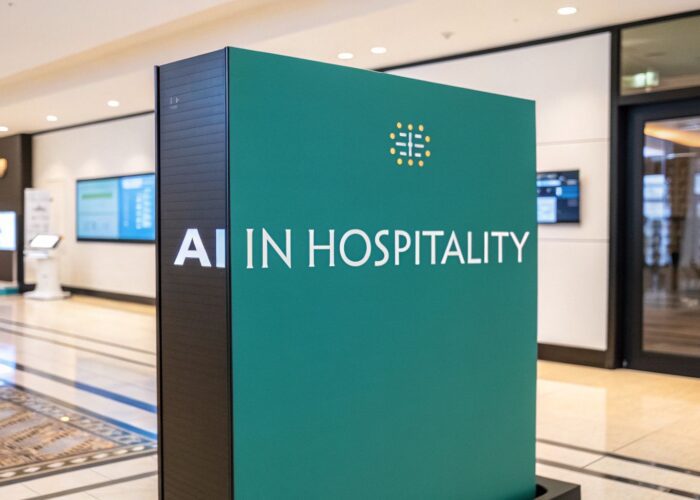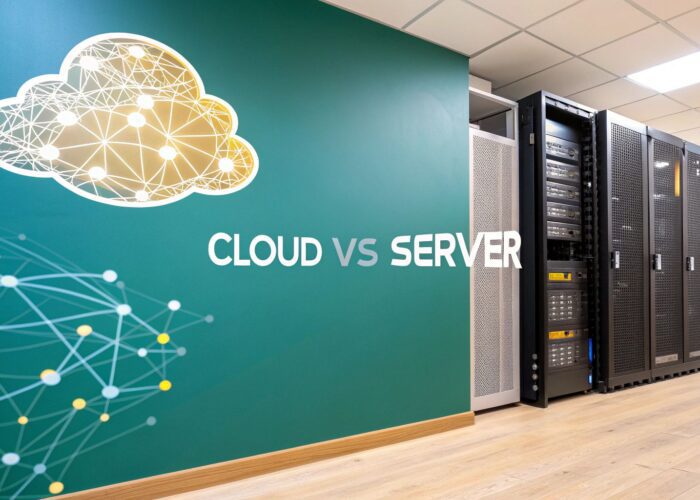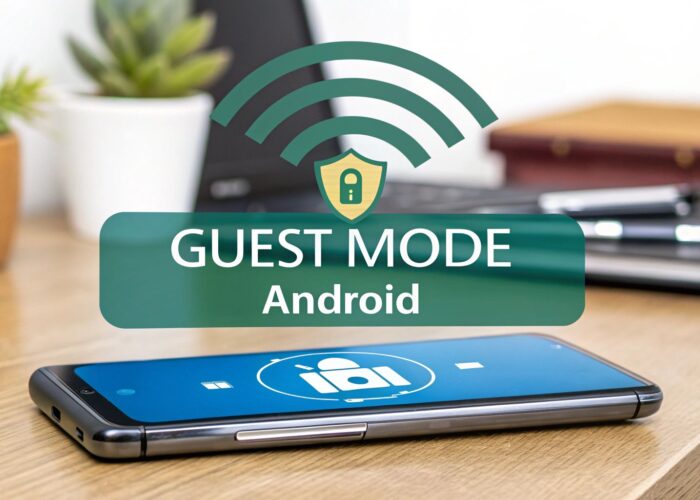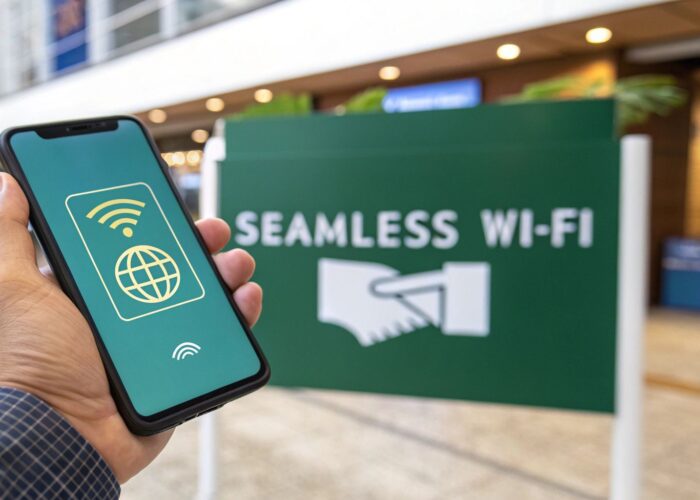Let's face it, the first thing most people do when they walk into a new place is pull out their phone and search for a Wi-Fi network. Getting online easily isn't just a nice perk anymore; it's a fundamental expectation. The entire journey to improve guest satisfaction really kicks off with that first connection.
A clunky, slow, or confusing login process creates an instant negative impression that's surprisingly hard to overcome.
Your Guest Experience Starts with Great Wi-Fi
Whether you're managing a sprawling university campus, a busy retail store, or a secure corporate office, a smooth Wi-Fi connection sets the tone for a person's entire visit. A modern guest network, especially one built on reliable hardware like Cisco Meraki, is one of your best tools for making people feel welcome. It’s not just about providing internet access—it's about designing a positive and memorable experience from the second a guest connects.
The goal is simple, secure access. In a bustling Education setting, students and campus visitors can't afford to wrestle with connectivity issues. For Retail businesses, a quick login can be the make-or-break moment for a shopper. And in BYOD Corporate sectors, visiting professionals expect robust security that doesn't force them to hunt down an IT person.
Why First Impressions Matter Online
Think of your Wi-Fi login page as your digital handshake. This is where smart Authentication Solutions and well-designed Captive Portals make all the difference. Imagine a guest connecting in just a few seconds, feeling both secure and welcomed. Technologies like IPSK and EasyPSK make this a reality by generating unique, secure credentials for each user without adding complexity.
This approach doesn't just protect your network; it sends a clear message to your guests that you take their digital safety seriously.
The Wi-Fi login is often the first branded interaction a guest has with your organization. Making it effortless and secure is a non-negotiable part of modern guest service. It immediately shows you're professional and care about their experience.
The importance of a solid Wi-Fi foundation can't be overstated, as it directly influences how visitors perceive your organization.
How Wi-Fi Impacts Guest Satisfaction in Key Sectors
This table shows just how critical a seamless connection is across different environments. The expectations—and the consequences of failing to meet them—vary, but the underlying need for great Wi-Fi is universal.
| Sector | Primary Wi-Fi Satisfaction Driver | Negative Impact of Poor Wi-Fi |
|---|---|---|
| Education | Reliable access to online learning materials and campus resources. | Students fall behind, visitors feel disconnected, and campus reputation suffers. |
| Retail | Quick, easy login to access deals, product info, or in-store apps. | Shoppers become frustrated, abandon carts, and are unlikely to return. |
| Corporate | Secure, fast connection for visiting clients and partners to stay productive. | Visitors see the company as unprofessional or outdated, meetings are disrupted. |
As you can see, poor Wi-Fi isn't just a minor inconvenience; it can have real, tangible consequences for your core objectives, whether that's learning, sales, or business relationships.
While a great connection is the perfect starting point, it's just one piece of the puzzle. It's always a good idea to brush up on proven strategies to improve customer satisfaction to see how Wi-Fi fits into the bigger picture.
For a more detailed look at the technical setup, our guide on how to set up guest Wi-Fi is the perfect resource. By focusing on a superior Wi-Fi experience from the very first click, you lay the foundation for overall satisfaction and turn a simple utility into a powerful relationship-building tool.
Design a Captive Portal That Welcomes Guests
Think of your guest Wi-Fi captive portal as a digital handshake. It's often the very first branded interaction a visitor has with your business, making it a pivotal moment in their experience. A clunky, confusing, or untrustworthy-looking login page can instantly derail that first impression.
The real goal here is to design a user-friendly login that gets guests online fast while subtly reinforcing your brand's identity. It should feel like a welcoming gateway, not an obstacle course.
Making Logins Simple and Secure
Fortunately, modern Authentication Solutions integrated with powerful hardware from partners like Cisco and Cisco Meraki make this process straightforward. You can now build beautiful, responsive captive portals that look sharp and professional on any device, from a phone to a laptop. The trick is to match the login process to the specific user's needs.
Different environments call for different login strategies.
- Retail: A quick social media login is perfect for shoppers. They get online instantly without filling out tedious forms, which is exactly what they want.
- Education: A campus setting has multiple user types. Students and staff might need a secure login tied to their university credentials, while campus visitors need a much simpler, separate option.
- BYOD Corporate: For guests visiting a corporate office, security is the top priority. Secure options like EasyPSK can provide a unique password for each guest, keeping your internal network safe while giving them peace of mind.
This flexibility is what turns a simple login into a powerful tool for improving the guest experience. By exploring the options within a well-designed captive portal for Wi-Fi, you can ensure every visitor gets the right level of access without the friction.
Turning a Login Into an Opportunity
A great captive portal does more than just grant internet access. Much like how effective digital signage solutions work in a physical space, your login page is a prime opportunity to engage directly with your guests.
For instance, you could customize your portal with a warm welcome message, promote a daily special, or even offer a discount coupon to encourage a return visit. It’s these small touches that transform a technical step into a memorable part of their experience.
The hospitality industry is a perfect example of this in action. With traveler numbers hitting 1.1 billion in just nine months last year, the expectations of guests—from digital nomads to families—are changing fast. To keep pace, businesses must use every available tool to personalize and enhance the guest journey from the moment they walk in the door. By optimizing your captive portal, you’re not just providing Wi-Fi; you're actively building a better, more modern relationship with your guests.
Secure Your Network and Empower Your Guests
Offering guest Wi-Fi is a must these days, but it can feel like you're leaving the front door to your network unlocked. This is a real headache in places like corporate offices with bring-your-own-device (BYOD) policies or on school campuses where sensitive student data is a top priority. The trick is to find that sweet spot between easy access for guests and iron-clad protection for your network.
We've all seen it: the single Wi-Fi password scribbled on a piece of paper and taped to a wall. That old-school method isn't just a pain; it's a huge security risk. Thankfully, there’s a much better way to handle things without forcing your guests through a complicated corporate login process that would just frustrate them.
Simplify Security with Individual Keys
This is where a technology called IPSK (Identity Pre-Shared Key) completely changes the game. Put simply, it's like giving every single guest their own personal, secure key to your Wi-Fi network. This one move drastically improves security because one person's access can't be used to compromise everyone else. When you pair this with top-notch hardware from partners like Cisco Meraki, you get a system that’s incredibly reliable.
Think about a bustling corporate office. You might have dozens of clients, contractors, and partners coming through your doors every day. Instead of handing out the same password to all of them, you can generate a unique key for each person. It’s a foundational step toward building a guest environment that people can actually trust.
A secure connection makes guests feel valued and protected. It sends a powerful message that you take their digital well-being seriously, which is a subtle but significant way to improve guest satisfaction.
And this kind of security isn't just for huge corporations anymore. Modern Authentication Solutions have made it practical for just about any organization.
Introducing EasyPSK for Effortless Access
Solutions like EasyPSK take this idea and make it incredibly simple for your non-technical staff to manage. Imagine a receptionist at a front desk or a manager in a Retail store being able to create a secure, temporary Wi-Fi pass for a guest in just a few clicks.
This puts the power in their hands, empowering your team to manage guest access on the fly without having to call the IT department for every single visitor.
Here’s how this plays out in the real world:
- Education: A university can issue a temporary, secure key for a visiting professor that automatically expires as soon as their lecture series is over.
- BYOD Corporate: A contractor on-site for a week-long project gets a unique key. It gives them internet access but keeps them safely off the internal corporate network.
- Retail: A pop-up shop in a mall can get secure access just for the weekend, and it's automatically shut off first thing Monday morning.
This approach gets rid of the constant headache of managing passwords while giving everyone—guests and staff alike—a smooth and secure experience. If you want to dig deeper, exploring some best practices for network security can give you more great ideas for building a resilient system. It’s all about creating a network that’s both welcoming and secure from the moment a guest connects.
Shape the Wi-Fi Experience to Your World
Think about it: a university student cramming for finals has completely different Wi-Fi needs than a shopper browsing your store or a contractor visiting a corporate office. A one-size-fits-all network just doesn't cut it anymore. If you try, you'll end up frustrating everyone. The real key to making people happy with your Wi-Fi is to stop seeing it as a utility and start treating it as a custom experience, built for specific groups.
This is exactly where a flexible platform running on robust hardware like Cisco Meraki really comes into its own. It gives you the power to create separate, secure, and genuinely useful online environments for different industries, and you can manage it all from one place.
A Smarter Approach for Education and Corporate Offices
In both Education and BYOD Corporate settings, the main headache is pretty much the same: how do you give a wide range of users simple, secure access without creating a constant stream of support tickets? The solution is found in smart Authentication Solutions that can tell one type of user from another.
Take a university, for example. Using its Cisco Meraki backbone, it can easily set up distinct, secure networks for students, faculty, and campus guests. This keeps sensitive academic data locked down while still providing straightforward Wi-Fi for everyone else. In the same way, a corporate office can make life easier for visiting contractors by giving them secure, temporary access that never touches the main company network.
This is where technologies like IPSK and EasyPSK are a game-changer. They let staff generate unique, secure login credentials on the fly, without ever needing to bother the IT department.
This simple infographic breaks down just how easy it is to create this kind of secure, temporary access.
As you can see, creating a secure, individual connection boils down to three simple, repeatable steps. It's so straightforward that even non-technical staff can handle it with confidence.
Connecting with Customers in Retail
When it comes to Retail, the goal shifts from airtight security to genuine engagement. Your Captive Portal is no longer just a login screen; it's one of your most powerful marketing tools. It’s your first chance to make a real connection with shoppers.
You can use the portal to:
- Boost loyalty program sign-ups: Offer a small discount or a free gift right on the login page in exchange for joining your program.
- Share timely offers: You've got a captive audience. Promote in-store specials or show off new arrivals to people who are physically in your store and ready to shop.
- Get instant feedback: Ask a quick, one-question survey to learn what your shoppers want and find ways to make their visit even better.
By making the Wi-Fi login a moment of value, you turn a basic amenity into a memorable part of the shopping trip. It's a small detail that demonstrates you're thinking about your customers' experience beyond just giving them an internet connection.
This strategy of targeting your Wi-Fi experience mirrors how top brands consistently earn high satisfaction scores. Just look at Hilton's success in the J.D. Power Guest Satisfaction Index Study, which shows how powerful it is to segment your market. By creating unique experiences for different types of guests, they consistently hit—and exceed—expectations. That's a lesson we can apply directly to Wi-Fi. For more ideas built for this industry, check out our guide on hospitality Wi-Fi solutions.
Use Wi-Fi Analytics to Keep Improving
Think of your guest Wi-Fi as more than just an internet connection. It’s actually a rich source of data, and if you're only focused on providing access, you're missing a massive opportunity to understand your visitors and find new ways to make their experience better. It's time to connect the dots between how guests use your Wi-Fi and what they truly want.
By pairing your Cisco Meraki hardware with a smart platform, you can unlock a surprising amount of information about visitor behavior. This isn't about invasive tracking; it's about seeing the bigger picture through anonymous trends that help you make smarter decisions for your venue.
Uncover Actionable Insights from Your Network
Imagine knowing exactly when your space gets busiest or which areas people tend to hang out in the longest. That's the power of Wi-Fi analytics. You can start tracking key metrics that paint a clear picture of how guests move through and interact with your physical space.
For instance, you can monitor:
- Peak Usage Times: Pinpoint your busiest hours to make sure you have enough staff and resources ready to go.
- Dwell Times: See how long visitors stay in certain zones—a goldmine for a Retail store looking to optimize its layout.
- Visitor Flow: Track the most popular paths people take, helping you place key services or promotions right where they'll be seen.
By looking at this data, you stop guessing what your guests want and start knowing what they do. This shift is fundamental to making proactive improvements that genuinely enhance their visit.
These insights are incredibly valuable no matter your industry. A university could spot underused study areas and repurpose them, while a BYOD Corporate office could manage meeting room availability based on what the real usage patterns show.
Turning Data into Better Experiences
The real magic happens when you use this data to make tangible changes. Let's say your analytics show a long dwell time near a specific product display in your retail shop. You now know that's a high-interest area. Maybe it's the perfect spot to place a knowledgeable staff member to answer questions and engage with shoppers.
This data-driven approach is becoming essential. Recent industry benchmarks reveal that while global guest satisfaction is hitting record highs, the volume of guest reviews is barely growing. This tells us that even though services are improving, getting direct feedback is still a huge challenge. Wi-Fi analytics helps fill that gap, offering insights without you having to ask for them in a survey.
By using location analytics from your guest network, you create a continuous feedback loop. You can test a new store layout, a new campus signage plan, or a different office configuration and see the impact on visitor behavior almost immediately. This ongoing process of refinement is the key to not just meeting guest expectations, but consistently exceeding them.
Your Top Guest Wi-Fi Questions, Answered
If you're trying to figure out the best way to offer guest Wi-Fi, you’re not alone. Getting it right is key to keeping people happy, but the tech can seem a bit much. Let’s cut through the noise and answer some of the most common questions people have when setting up a great guest network.
Think of this as your cheat sheet for moving beyond a basic, password-on-the-wall setup to something that genuinely improves the guest experience and keeps your own network secure.
What's a Captive Portal, and Why Should I Care?
You’ve definitely seen a captive portal before—it’s that branded webpage that pops up right after you select a guest Wi-Fi network. It's the first digital handshake you have with your visitor, and that first impression matters. A clean, professional portal, especially one built on a reliable platform like Cisco Meraki, immediately tells guests you’re serious about their experience.
A clunky, slow-loading page, on the other hand, is an instant source of frustration. The portal is more than just a login screen; it’s your chance to welcome guests, share a daily special, or simply get your brand in front of them. In Retail or Education spaces, this turns a simple utility into a real engagement opportunity.
How Can I Make Wi-Fi Secure Without Annoying My Guests?
This is where IPSK (Identity Pre-Shared Key) comes in. It’s one of the best Authentication Solutions out there because it ditches the old "one password for everyone" model. Instead, each person or device gets its own unique key. This simple change dramatically boosts security, stopping unauthorized users from hopping onto your network and giving guests peace of mind.
We’ve seen how solutions like EasyPSK make this incredibly straightforward in the real world. A receptionist in a BYOD Corporate office can generate a secure, temporary key for a visitor in just a few clicks. The guest gets a super-secure connection that feels as easy as logging in at home. It's a massive win.
Is It Possible to Use Wi-Fi Data to Improve My Business?
Absolutely. This is one of the most overlooked benefits of a modern Wi-Fi system. Analytics tools, particularly those that integrate with powerful hardware from Cisco Meraki, can tell you so much. You can see foot traffic patterns, identify which areas are most popular, and know your busiest hours down to the minute.
Imagine a retail store using that data to adjust staffing levels for the lunch rush, or a university discovering that a certain library floor is always empty. They can then figure out why and make changes. When you use data to make smarter decisions, you create a better environment for everyone, and that directly boosts guest satisfaction.
Ready to stop just offering Wi-Fi and start using it to create a better guest experience? Splash Access specializes in secure, intelligent Wi-Fi solutions designed for Cisco Meraki. Find out how we can help you build an unforgettable connection with your guests.
